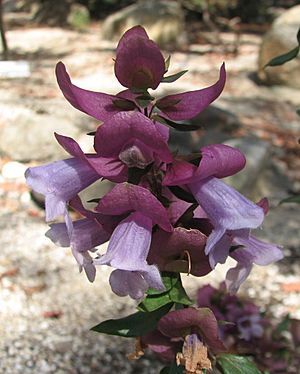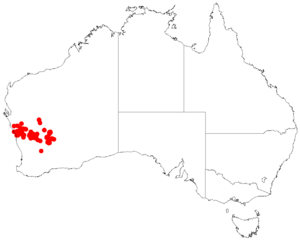Magnificent prostanthera facts for kids
Quick facts for kids Magnificent prostanthera |
|
|---|---|
 |
|
| In Maranoa Gardens | |
| Scientific classification | |
| Genus: |
Prostanthera
|
| Species: |
magnifica
|
 |
|
| Occurrence data from AVH | |
Prostanthera magnifica, also known as the magnificent prostanthera, is a beautiful flowering plant from Western Australia. It belongs to the Lamiaceae family, which includes mint plants! This shrub can be slender or spread out, growing upright. It has furry stems and oval-shaped leaves. Its flowers are usually pale purple, light blue, or pink, with striking dark purple parts called sepals.
Contents
What Does the Magnificent Prostanthera Look Like?
The magnificent prostanthera is a slim or spreading bush that grows straight up. It can reach a height of about 0.4 to 2.5 meters. This plant has branches that are a bit flat and usually furry.
Its leaves are oval-shaped, about 15 to 44 millimeters long and 5 to 10 millimeters wide. Each leaf sits on a small stalk called a petiole, which is about 1 to 4 millimeters long.
The flowers grow in groups of six to eighteen near the ends of the branches. Each flower has its own tiny stalk, called a pedicel, about 2.5 to 6 millimeters long. The sepals, which are like small leaves protecting the flower, are dark purple. They form a tube about 2 to 4 millimeters long. These sepals have two big, egg-shaped parts. The lower part is 4 to 10 millimeters long, and the upper part is much larger, about 15 to 26 millimeters long.
The petals of the flower are pale purple, light blue, or pink, and they often have dark purple spots. They are about 16 to 25 millimeters long and form a tube about 15 to 20 millimeters long. The flower has two "lips." The middle part of the lower lip is 4 to 7.5 millimeters long, and the side parts are 4 to 6 millimeters long. The upper lip is 4 to 8 millimeters long and has a small notch in the middle. You can see these lovely flowers blooming from August to November.
How Was This Plant Named?
The magnificent prostanthera was first officially described in 1943. A scientist named Charles Austin Gardner gave it its formal name. He wrote about it in the Journal of the Royal Society of Western Australia. He studied plant samples collected near Mullewa by William Blackall.
Where Does the Magnificent Prostanthera Grow?
This beautiful mintbush is found in Western Australia. It likes to grow in rocky places like granite outcrops, ironstone hills, and cracks in rocks. You can find it in several different natural areas, including the Avon Wheatbelt, Coolgardie, Geraldton Sandplains, Murchison, and Yalgoo regions.
Is This Plant Endangered?
Good news! The magnificent prostanthera is not considered to be in danger. The Western Australian Government's Department of Parks and Wildlife has classified it as "not threatened." This means there are enough of these plants in the wild for now.
How Can You Grow This Plant?
If you want to grow magnificent prostanthera, it prefers a sunny or partly shaded spot. It also needs soil that drains water well. This plant doesn't like frost or too much humidity.
You can grow new plants from both seeds and cuttings. However, seeds can take a long time to sprout. Sometimes, people use a special method called grafting. This is where you join a piece of the magnificent prostanthera onto the root system of another plant, like Westringia fruticosa or Prostanthera striatiflora. Grafting can help the plant live longer. When grafted onto Prostanthera striatiflora, the magnificent prostanthera can flower for a longer time and grows better.

